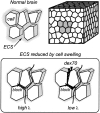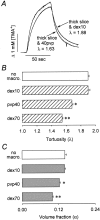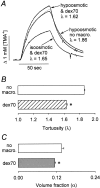Dead-space microdomains hinder extracellular diffusion in rat neocortex during ischemia
- PMID: 12967997
- PMCID: PMC6740703
- DOI: 10.1523/JNEUROSCI.23-23-08351.2003
Dead-space microdomains hinder extracellular diffusion in rat neocortex during ischemia
Abstract
During ischemia, the transport of molecules in the extracellular space (ECS) is obstructed in comparison with healthy brain tissue, but the cause is unknown. Extracellular tortuosity (lambda), normally 1.6, increases to 1.9 in ischemic thick brain slices (1000 microm), but drops to 1.5 when 70,000 Mr dextran (dex70) is added to the tissue as a background macromolecule. We hypothesized that the ischemic increase in lambda arises from diffusion delays in newly formed dead-space microdomains of the ECS. Accordingly, lambda decreases when dead-space diffusion is eliminated by trapping dex70 in these microdomains. We tested our hypothesis by analyzing the diffusion of several molecules in neocortical slices. First we showed that diffusion of fluorescent dex70 in thick slices declined over time, indicating the entrapment of background macromolecules. Next, we measured diffusion of tetramethylammonium (TMA+) (74 Mr) to show that the reduction of lambda depended on the size of the background macromolecule. The synthetic polymer, 40,000 Mr polyvinylpyrrolidone, reduced lambda in thick slices, whereas 10,000 Mr dextran did not. The dex70 was also effective in normoxic slices (400 microm) after hypoosmotic stress altered the ECS to mimic ischemia. Finally, the dex70 effect was confirmed independently of TMA+ using fluorescent 3000 Mr dextran as a diffusion marker in thick slices: lambda decreased from 3.29 to 2.44. Taken together, these data support our hypothesis and offer a novel explanation for the origin of the large lambda observed in ischemic brain. A semiquantitative model of dead-space diffusion corroborates this new interpretation of lambda.
Figures





Similar articles
-
Gliotoxin-induced swelling of astrocytes hinders diffusion in brain extracellular space via formation of dead-space microdomains.Glia. 2014 Jul;62(7):1053-65. doi: 10.1002/glia.22661. Epub 2014 Mar 31. Glia. 2014. PMID: 24687699 Free PMC article.
-
Dextran decreases extracellular tortuosity in thick-slice ischemia model.J Cereb Blood Flow Metab. 2000 Sep;20(9):1306-10. doi: 10.1097/00004647-200009000-00005. J Cereb Blood Flow Metab. 2000. PMID: 10994852
-
Extracellular diffusion is fast and isotropic in the stratum radiatum of hippocampal CA1 region in rat brain slices.Hippocampus. 2005;15(4):441-50. doi: 10.1002/hipo.20068. Hippocampus. 2005. PMID: 15719413
-
Contribution of dead-space microdomains to tortuosity of brain extracellular space.Neurochem Int. 2004 Sep;45(4):467-77. doi: 10.1016/j.neuint.2003.11.011. Neurochem Int. 2004. PMID: 15186912 Review.
-
Diffusion in brain extracellular space.Physiol Rev. 2008 Oct;88(4):1277-340. doi: 10.1152/physrev.00027.2007. Physiol Rev. 2008. PMID: 18923183 Free PMC article. Review.
Cited by
-
Gliotoxin-induced swelling of astrocytes hinders diffusion in brain extracellular space via formation of dead-space microdomains.Glia. 2014 Jul;62(7):1053-65. doi: 10.1002/glia.22661. Epub 2014 Mar 31. Glia. 2014. PMID: 24687699 Free PMC article.
-
Morphogen gradients are regulated by porous media characteristics of the developing tissue.Development. 2025 Jul 1;152(13):dev204312. doi: 10.1242/dev.204312. Epub 2025 Jul 14. Development. 2025. PMID: 40462756 Free PMC article.
-
Plasticity of GABA transporters: an unconventional route to shape inhibitory synaptic transmission.Front Cell Neurosci. 2014 May 13;8:128. doi: 10.3389/fncel.2014.00128. eCollection 2014. Front Cell Neurosci. 2014. PMID: 24860430 Free PMC article.
-
From normal to anomalous diffusion in comb-like structures in three dimensions.J Chem Phys. 2014 Aug 7;141(5):054907. doi: 10.1063/1.4891566. J Chem Phys. 2014. PMID: 25106613 Free PMC article.
-
Increased Extrasynaptic Glutamate Escape in Stochastically Shaped Probabilistic Synaptic Environment.Biomedicines. 2022 Sep 26;10(10):2406. doi: 10.3390/biomedicines10102406. Biomedicines. 2022. PMID: 36289667 Free PMC article.
References
-
- Aschner M, Allen JW, Kimelberg HK, LoPachin RM, Streit WJ ( 1999) Glial cells in neurotoxicity development. Annu Rev Pharmacol Toxicol 39 : 151-173. - PubMed
-
- Banay-Schwartz M, Gergely A, Lajtha A ( 1974) Independence of amino acid uptake from tissue swelling in incubated slices of brain. Brain Res 65 : 265-276. - PubMed
-
- Basedow AM, Ebert KH ( 1979) Production, characterization, and solution properties of dextran tractions of narrow molecular weight distributions. J Polym Sci Pol Sym 66 : 101-115.
-
- Bohrer MP, Patterson GD, Carroll PJ ( 1984) Hindered diffusion of dextran and Ficoll in microporous membranes. Macromolecules 17 : 1170-1173.
-
- Burton BA, Brant DA ( 1983) Comparative flexibility, extension, and conformation of some simple polysaccharide chains. Biopolymers 22 : 1769-1792.
Publication types
MeSH terms
Substances
Grants and funding
LinkOut - more resources
Full Text Sources
Other Literature Sources
